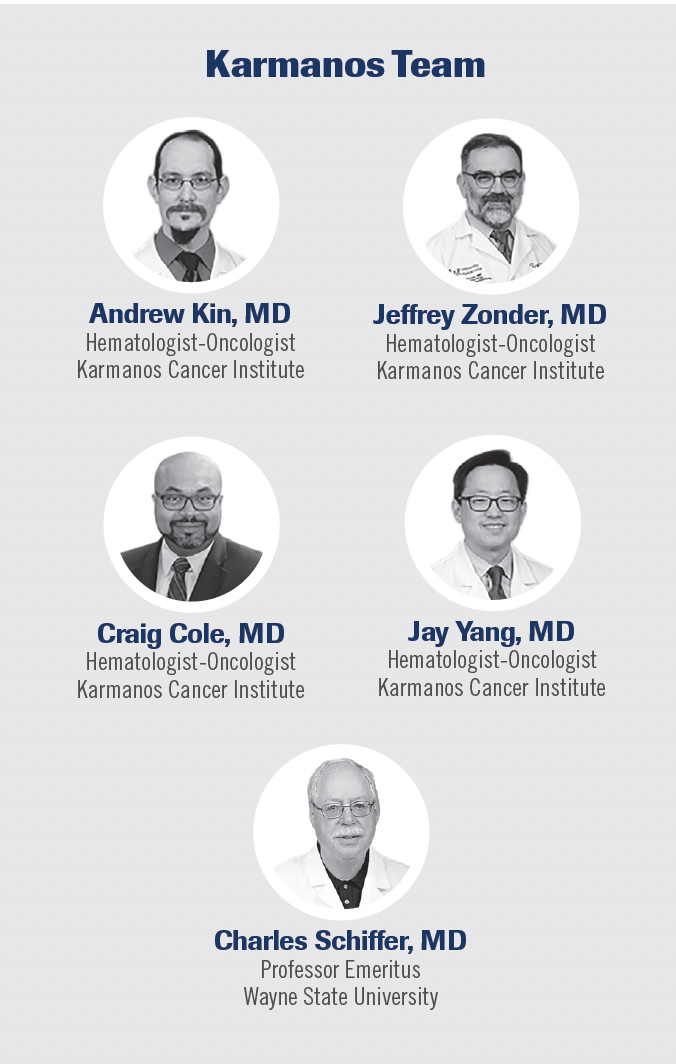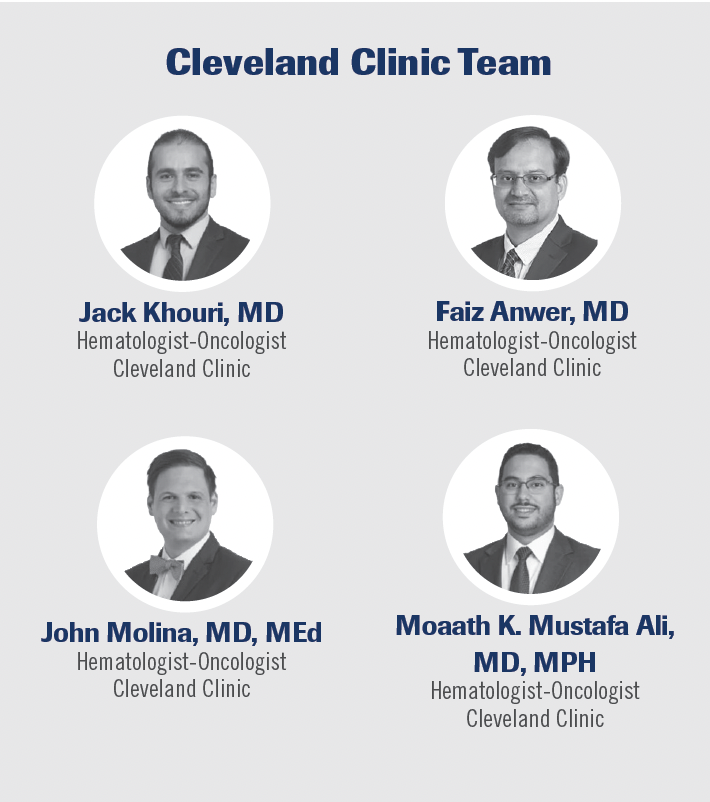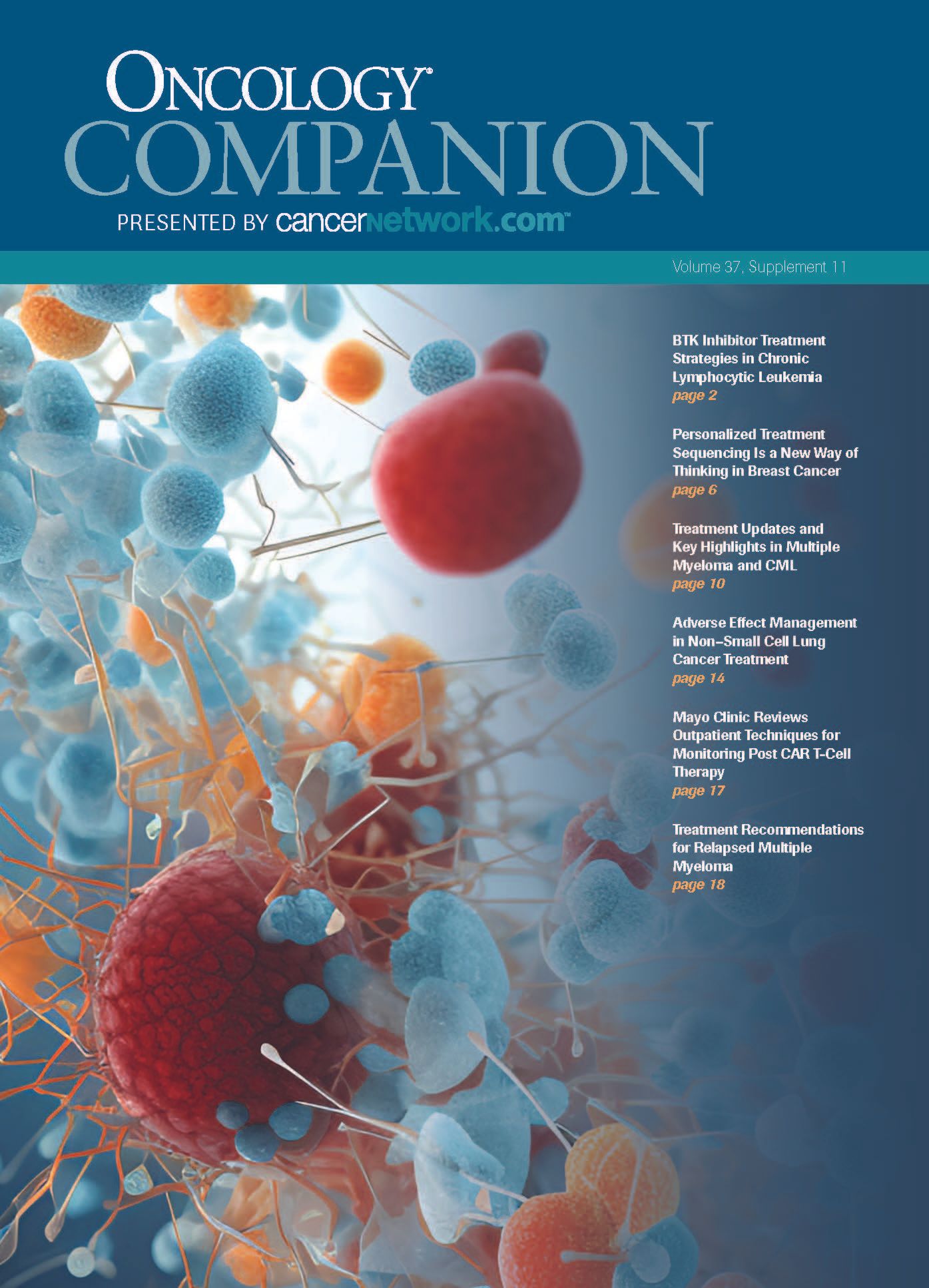Treatment Updates and Key Highlights in Multiple Myeloma and CML
Karmanos Cancer Institute and Cleveland Clinic gave presentations regarding treatment of multiple myeloma and chronic myeloid leukemia in the latest Face Off.
Karmanos Cancer Institute Team

Clinicians from Karmanos Cancer Institute and Cleveland Clinic specializing in chronic myeloid leukemia (CML) and multiple myeloma met to discuss top trials in the space. The data presented highlight effective treatments and potential new standard-of-care options in the space.
Cleveland Clinic Team

CARTITUDE-4 Trial
A total of 419 patients were enrolled in the phase 3 CARTITUDE-4 trial (NCT04181827) and randomly assigned to receive ciltacabtagene autoleucel (cilta-cel; Carvykti) (n = 208) or standard-of-care (SOC) therapy (n = 211). Of the patients in the cilta-cel group, 84.6% received the treatment compared with 98.6% in the SOC group. The median follow-up was 15.9 months.1
A significantly lower risk of disease or death was observed in the cilta-cel group (HR, 0.26; 95% CI, 0.18-0.38; P < .001). For those in the cilta-cel group, the median progression-free survival (PFS) was not reached vs 11.8 months (95% CI, 9.7-13.8) in the SOC group. The PFS at 12 months in the intent-to-treat population was 75.9% (95% CI, 69.4%-81.1%) vs 48.6% (95% CI, 41.5%-55.3%), respectively. Twenty-two patients experienced disease progression or death 8 weeks after randomization in the cilta-cel group vs 8 patients in the SOC group.
A complete response or better was observed in 73.1% of patients in the cilta-cel group vs 21.8% in the SOC group (risk ratio [RR], 2.9; 95% CI, 2.3-3.7; P < .001; odds ratio [OR], 10.3; 95% CI, 6.5-16.4). The overall response rate between both groups was 84.6% and 67.3%, respectively (RR, 2.2; 95% CI, 1.5-3.1; P < .001; OR, 3.0; 95% CI, 1.8-5.0). A response lasting for 12 months or more was estimated to occur in 84.7% of patients in the cilta-cel group and 63.0% in the SOC group.
Minimal residual disease (MRD) activity was observed in 60.6% of the cilta-cel group vs 15.6% in the SOC group (RR, 2.2; 95% CI, 1.8-2.6; P < .001; OR, 8.7; 95% CI, 5.4-13.9). For patients who had evaluable samples, MRD negativity occurred in 87.5% and 32.7% of patients, respectively.At the time of reporting, the overall survival data were still immature (HR, 0.78; 95% CI, 0.5-1.2; P = .26). Of note, at 12 months, 84.1% of patients in the cilta-cel group vs 83.6% in the SOC group were alive.
Grade 3/4 adverse effects (AEs) occurred in 96.6% of patients in the cilta-cel group vs 94.2% in the SOC group. Serious AEs were reported in 44.2% vs 38.9%, respectively. In the SOC group, 1.4% of patients discontinued treatment because of AEs, and 55.3% had treatment delays. Of note, 39 patients in the cilta-cel group and 46 patients in the SOC group died. Cytokine release syndrome (CRS) was observed in 76.1% of patients in the cilta-cel group. The median time to CRS onset was 8 days, and the duration was 3 days.
Kin: Did they allow bridging therapy?
Khouri: They did allow bridging, and it was basically the same treatment that was given to the standard-of-care arm. Either they were given pomalidomide [Pomalyst] and dexamethasone or bortezomib [Velcade], pomalidomide, and dexamethasone.
Ali: I’ve noticed in all or almost all chimeric antigen receptor [CAR] T-cell treatments that in PFS, there’s no plateau, and that tells you that CAR T-cell therapy is not curative. Now we have had long follow-up durations, especially for lymphomas and even for certain multiple myeloma products. It is an option, but not necessarily the last option that will cure the patient.
Zonder: It is a head-to-head victory over approved triplet [therapies] in this same space. It may not be curative, as other therapies aren’t, but it still represents an emerging superior option compared with some regimens that we’re already using.
Anwer:At this time, we may not be interested in doing a head-to-head because the speed at which the immunotherapies are being developed in this space is fast. On one hand, we have patients who are [many] lines of therapy [deep] and who are always in need of the next line of therapy. We always need the next phase 1 or phase 2 study in the immunotherapy space. We have emerging data. If we compare idecabtagene vicleucel [Abecma] and cilta-cel, we know which product has the longest PFS available at this time. Of course, there are unique individual differences in the toxicity and the cytokine release syndrome.
OPTIC Trial
The 3-year update from the phase 2 OPTIC trial (NCT02467270) analyzed ponatinib (Iclusig) in patients with chronic-phase CML.2 The trial enrolled patients who were resistant to 2 or more tyrosine kinase inhibitors or were BCR::ABL1 T315I mutation positive. Patients were randomly assigned 1:1:1 to ponatinib at 45 mg, 30 mg, or 15 mg daily. If patients achieved a BCR::ABL1 value of 1% or less, they could be dose reduced to the 15-mg group. In the 15-mg group, they could be reduced to 10 mg if AEs were common. The primary end point was a BCR::ABL1 value of 1% or less at 12 months.
The BCR::ABL1 value-of-1%-or-less response rate at 36 months was 60.2% (95% CI, 49.5%-70.2%) in the 45-mg group, 39.8% (95% CI, 29.8%-50.5%) in the 30-mg group, and 39.6% (95% CI, 29.5%-50.4%) in the 15-mg group. The 3-year PFS rate was 72.5% in the 45-mg group, 67.1% in the 30-mg group, and 69.7% in the 15-mg group. The probability of overall survival at 3 years was 87.4% in the 45-mg group, 87.0% in the 30-mg group, and 92.3% in the 15-mg group.
The BCR::ABL1 response rate at 36 months was assessed based on mutation status at baseline. Patients with a T315I mutation had a response rate of 64% in the 45-mg cohort, 25% in the 30-mg group, and 16% in the 15-mg group. For mutations other than T315I, the response rates were 56% in the 45-mg group, 40% in the 20-mg group, and 50% in the 15-mg group. Individuals with no mutation had response rates of 60% in the 45-mg group, 45% in the 30-mg group, and 45% in the 15-mg group.
Grade 3/4 treatment-emergent AEs (TEAEs) occurred in 67% of patients in the 45-mg group, 64% in the 30-mg group, and 63% in the 15-mg group. Grade 5 TEAEs occurred in 3% of patients in both the 45-mg and 15-mg groups and in 1% of the 30-mg group.
References
- San-Miguel J, Dhakal B, Yong K, et al. Cilta-cel or standard care in lenalidomide-refractory multiple myeloma. N Engl J Med. 2023;389(4):335-347. doi:10.1056/NEJMoa2303379
- Cortes JE, Deininger MW, Lomaia E, et al. Three-year update from the Optic trial: a dose-optimization study of 3 starting doses of ponatinib. Blood. 2022;140(suppl 1):1495-1497. doi:10.1182/blood-2022-157822
EP: 1.Team Introductions: MM Experts From Karmanos Cancer Institute and Cleveland Clinic
EP: 2.ALLIANCE A061202: Ixazomib Plus Pomalidomide and Dexamethasone in Multiple Myeloma
EP: 3.Cross Q&A: Treatment Considerations for Ixa-Pom-Dex in Multiple Myeloma
EP: 4.CARTITUDE-4: Cilta-Cel in Lenalidomide-Refractory MM
EP: 5.Cross Q&A: Efficacy of CAR T-Cell Therapy in MM
EP: 6.Outcomes After Biochemical or Clinical Progression in Patients with MM
EP: 7.Cross Q&A: Retrospective Study of Patients With MM
EP: 8.REMIX: Real-World Effectiveness of Ixazomib with Lenalidomide and Dexamethasone in MM
EP: 9.Cross Q&A: Clinical Application of Ixa-Len-Dex for Patients With MM
EP: 10.DREAMM-3: Belantamab Mafodotin in Patients With Relapsed/Refractory MM
EP: 11.Treatment Updates and Key Highlights in Multiple Myeloma and CML
EP: 12.Cross Q&A: Role of Belantamab Mafodotin in MM

Navigating AE Management for Cellular Therapy Across Hematologic Cancers
A panel of clinical pharmacists discussed strategies for mitigating toxicities across different multiple myeloma, lymphoma, and leukemia populations.